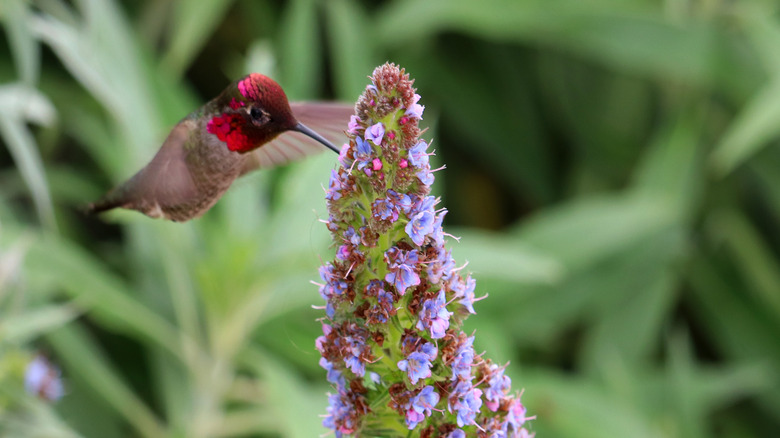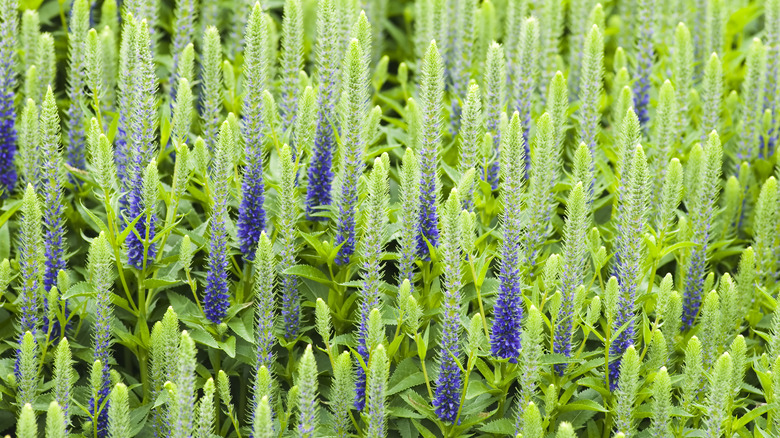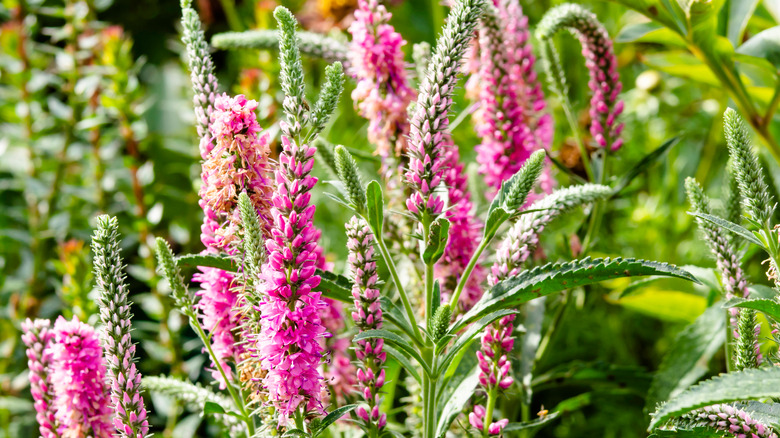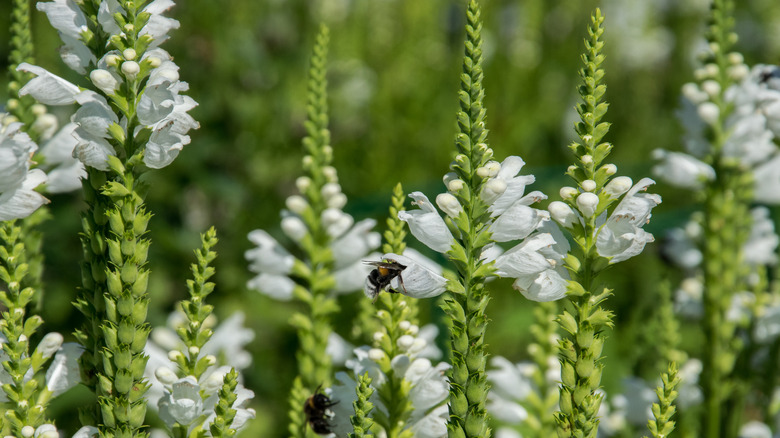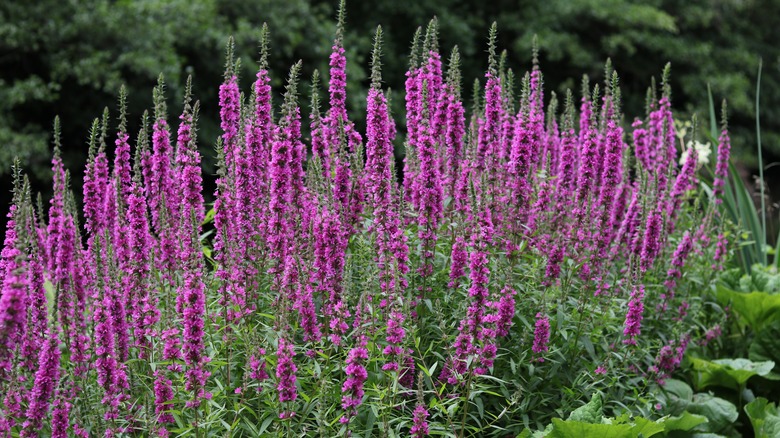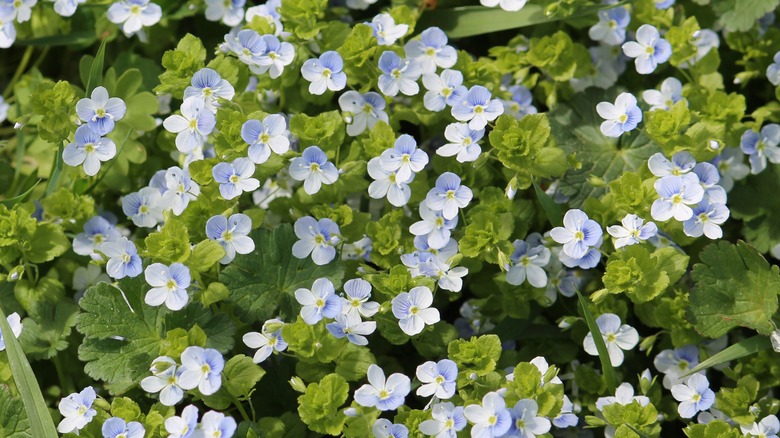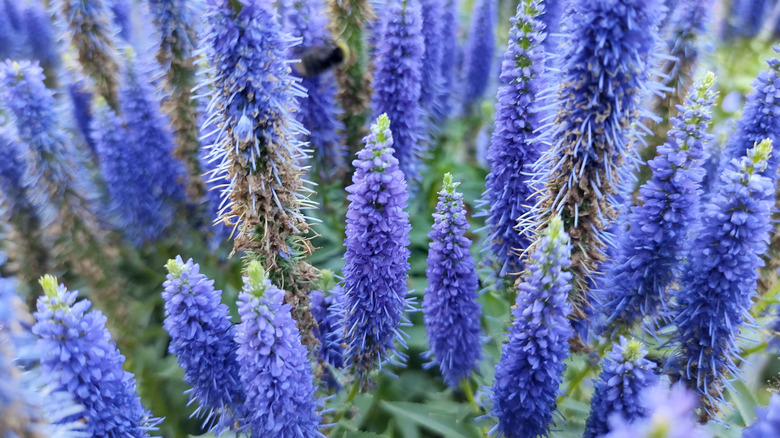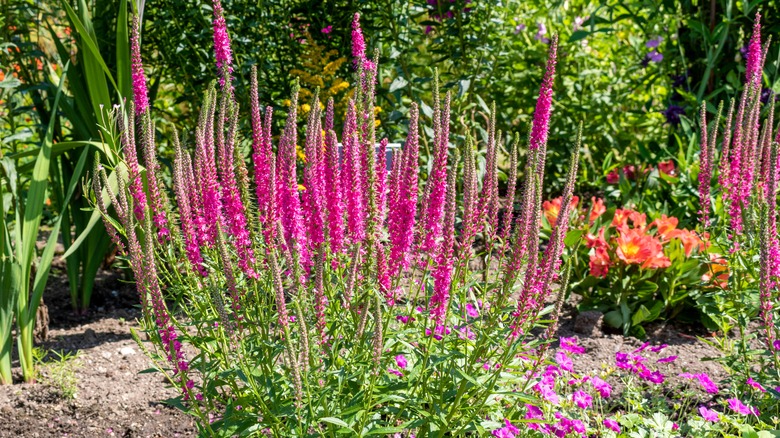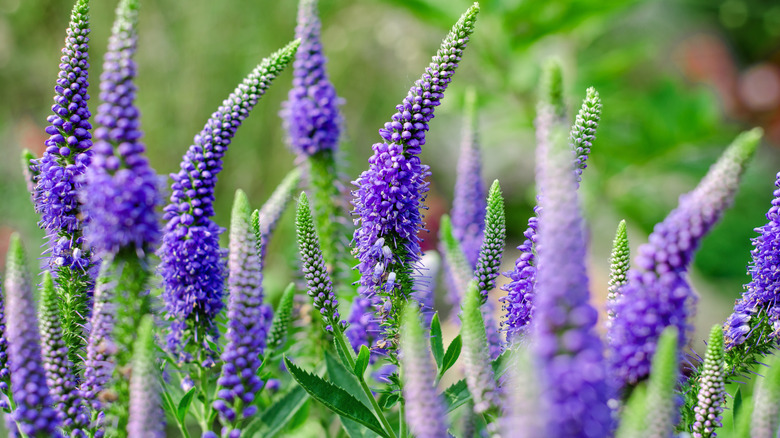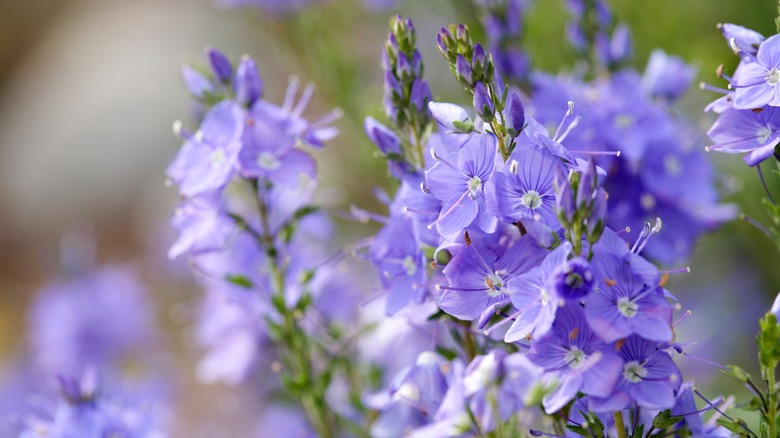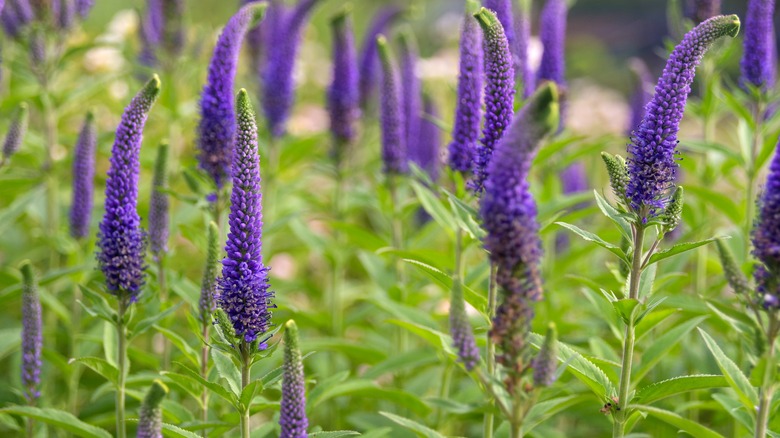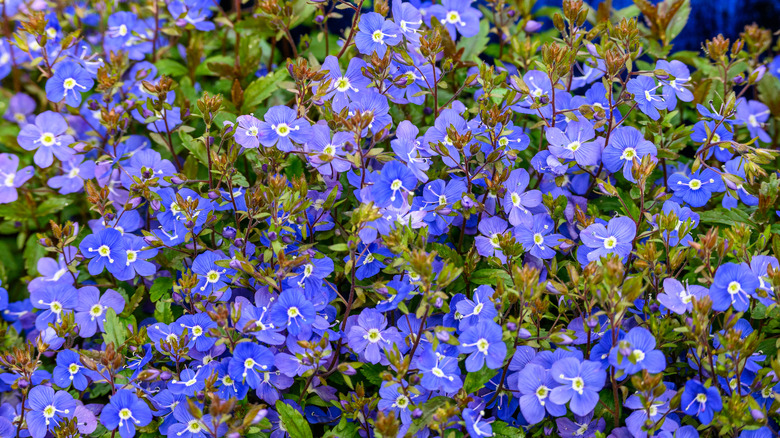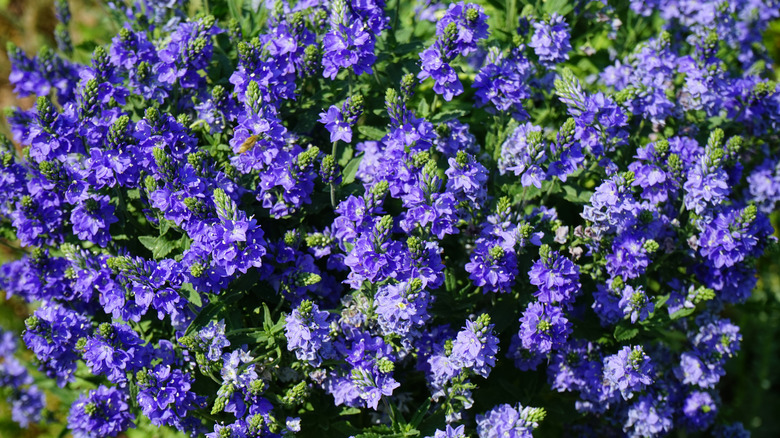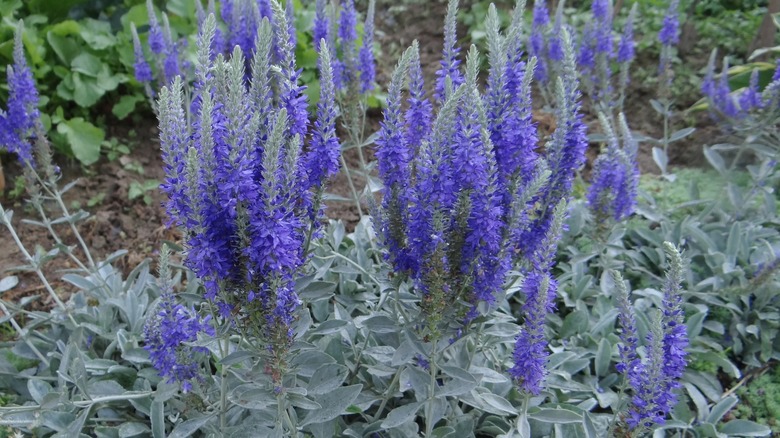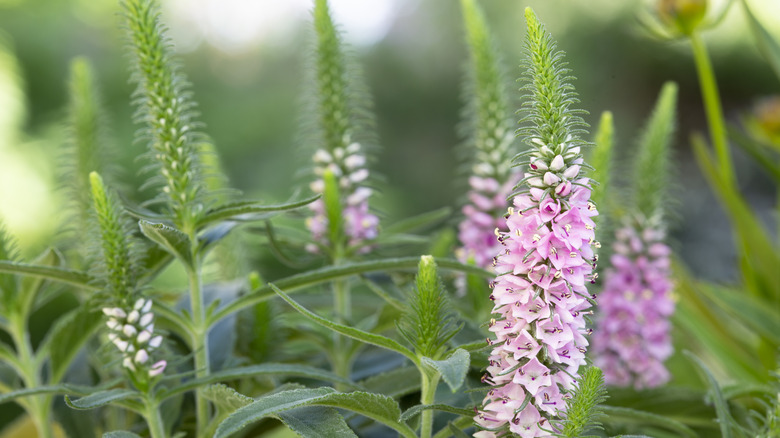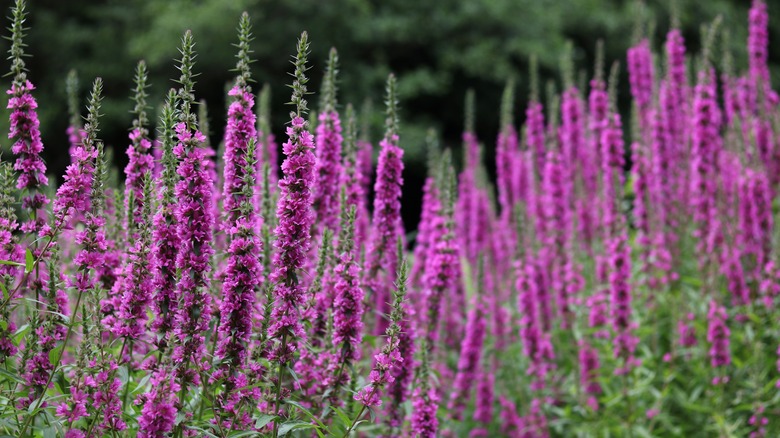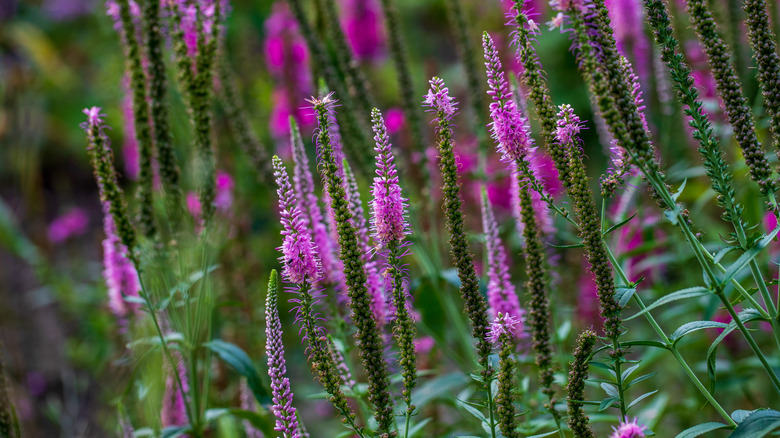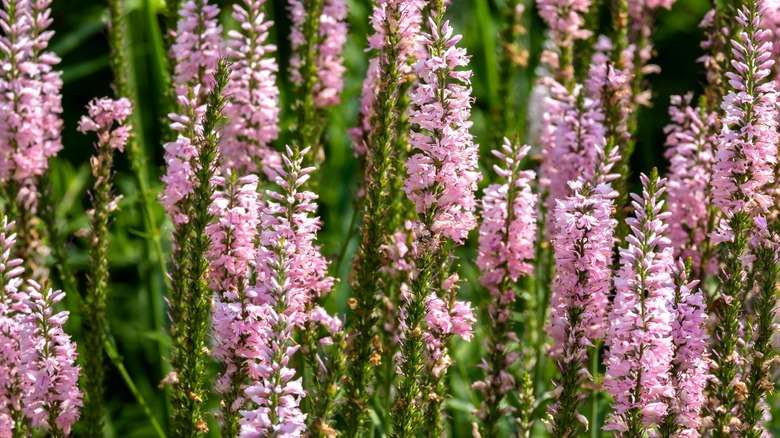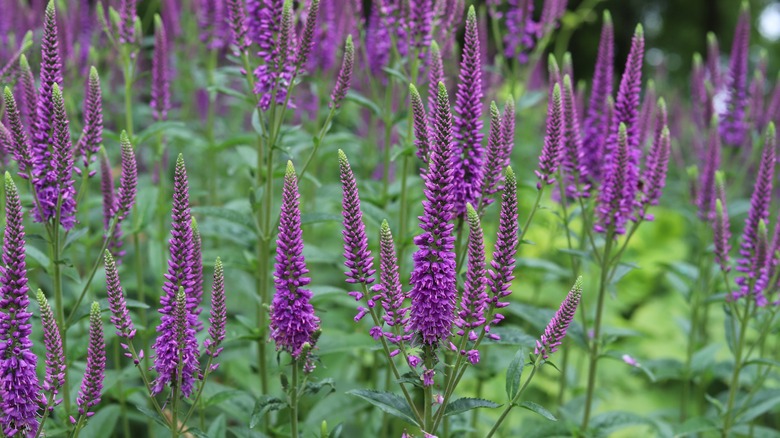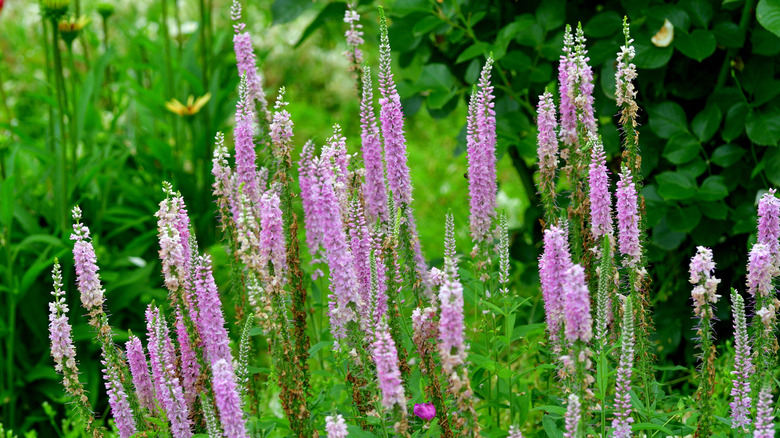19 Colorful Varieties Of Veronica Flowers You Can Plant To Attract Hummingbirds
Renowned as a pollinator-attracting plant, veronica features vibrant spiked blossoms that bees and butterflies love. Commonly known as speedwell, this deer-resistant and drought-tolerant flowering plant grows up to 3 feet tall and 2 feet wide. Veronica is low-maintenance and thrives in a variety of climates, adapting to most USDA Zones. Many varieties bloom throughout the season, starting with a first bloom in spring, throughout summer, and extending into the fall.
Veronica comes in a palette of purple, blue, pink, and white. The rich nectar and tubular, trumpet-shaped blooms make them highly attractive to hummingbirds. Additionally, choosing bright-colored flowers that hummingbirds are naturally drawn to, especially in shades of pink and red, makes your garden an irresistible target. The long flowering season of veronica also provides hummingbirds with a source of nectar throughout their active months. For gardeners looking for an easy-to-grow perennial, adding different types of veronica may be the hidden key to attracting hummingbirds to your garden.
1. First Glory
The 'First Glory' veronica is distinguished by its violet-blue flowers. This variety reaches heights of 20 inches tall and 18 inches wide. For optimal growth, 'First Glory' needs full sun of at least 6 to 8 hours per day. It thrives with consistent watering, especially in hotter climates. This veronica's moderate growth is perfect for gardeners looking for results without overwhelming upkeep. This variety needs fast-draining soil to prevent rot from water-logged conditions. Additionally, 'First Glory' is cold-hardy and heat tolerant, growing in Zones 4 through 9. It's an easy-to-grow variety to bring more pollinators to your garden.
2. Giles Van Hees
Small but mighty, the 'Giles Van Hees' grows only 6 inches tall and up to 12 inches wide but boasts hot-pink, fuzzy-looking flowers. This low-growing, compact, and spreading variety is perfectly suited for border placements or as a ground cover. It grows best in Zones 4 through 8, making it a versatile plant for a variety of climates. Aside from the nectar-rich flowers from this variety, its pink-hued color naturally helps attract hummingbirds. It does best in well-draining soil and is adapted to low-watering and moderately moist soil.
3. Icicle
This medium-growing veronica, 'Icicle,' grows up to 2 feet tall and 18 inches wide, and is viable in Zones 3 through 8. Known for striking, snow-white flowers that bloom all season, it provides a dense display of blossoms to attract pollinators throughout the garden. This long blooming period offers interest from early summer and late into the fall, making it a great choice for gardeners looking for multi-session bloomers. It's suitable as a ground cover and in xeriscape gardens due to its drought tolerance. This variety is also salt tolerant and is a versatile plant for coastal gardens or areas where salt spray is a common occurrence.
4. Ronica Fuchsia
'Ronica Fuchsia' grows between 12 and 18 inches tall and wide, making it the perfect size for perennial borders or along walkways. It thrives in part to full sun and adapts to a range of climates throughout Zones 4 to 9. The contrast of its pink rose-colored blooms and lush bright green foliage make this perennial pop in the garden. It's heat tolerant and deer and rabbit-resistant, attracting pollinators with its colorful and nectar-filled blooms. Plant Ronica Fuchsia alongside Icicle and First Glory for a mix of colors and heights to attract hummingbirds to your garden.
5. Sunshine
Unlike the typical varieties of veronica with tall, spindle-like flowers, 'Sunshine' has a creeping growth habit. Grown for its yellow-colored foliage, this speedwell flower is great as a ground cover or planted between stones. It forms a dense chartreuse mat that effortlessly handles foot traffic. This short perennial only reaches 1 to 2 inches in height and does well in all soil types, ranging from sandy to clayey. It thrives in full sun and in Zones 4 through 9. Its tiny pearly blue flowers are perfect for attracting hummingbirds and butterflies.
6. Royal Candles
A compact variety with bright blue flowers and deep green foliage, 'Royal Candles' grows up to 16 inches tall and 18 inches wide. Whether you choose to grow it in containers, a raised bed, or in the garden, make sure it receives partial or full sun. It also needs moist and well-draining soil for continuous blooming from June through August. Royal Candles' hardiness extends from Zone 4 through 8, making it a valuable flowering plant for gardeners looking for a tolerant and low-maintenance perennial to attract hummingbirds and create a pollinator garden.
7. Rotfuchs (Red Fox)
'Rotfuchs' or Red Fox thrives in well-drained, medium moisture soil. It's ideal for full sun, though it can handle light shade. The Red Fox variety is not drought-tolerant, so consistent watering and moisture are needed to help provide optimal growing conditions. Hardy in Zones 3 through 8, this speedwell can survive in below-freezing temperatures reaching -40 degrees Fahrenheit. This variety grows almost 2 feet high and wide with a compact and bushy growth habit. It produces dense, bright pink and red shades of blooms, naturally attracting hummingbirds to gardens.
8. Sunny Border Blue
The 'Sunny Border Blue' veronica flower is a variety known for its deep violet-blue, almost navy flowers and exceptionally long blooming period, stretching from mid-summer to late fall. Growing up to 2 feet high and about 18 inches wide, it adapts to all soil types, ranging from clay to sandy. It's easy to grow and maintain, and it needs full sun and moist soil conditions for optimal flower growth. With tooth-like, glossy green foliage and an abundance of eye-catching flowers, this is an excellent, resilient plant for any gardener to attract hummingbirds.
9. Royal Blue
'Royal Blue' packs a punch with large light blue periwinkle flowers. Blooming from May to June, this variety of veronica doesn't disappoint. It maintains a compact, mound-like shape, growing up to 18 inches tall and wide. This size makes it ideal for smaller garden landscapes. If left to its own devices, it self-seeds, covering your garden and spreading throughout spaces. Plant it with other varieties like Royal Candles or Icicle for a consistent show of blooms that turn your yard into a hummingbird haven throughout the summer and fall seasons.
10. Nana
'Nana' is characterized by dense, vertical spikes of deep blue flowers that bloom from June to August, growing only 8 inches tall and up to a foot wide. This veronica's attractive dark green toothy foliage is the perfect size for small garden spaces, as a ground cover, or as a thriller plant when designing a container garden. It flourishes in Zones 3-8 and has no serious disease or insect issues, but it needs well-draining soils to avoid root rot. The tubular flowers of this veronica complement hummingbirds' long beaks, allowing them to access nectar easily.
11. Georgia Blue
A cottage-core charming ground cover, this creeping veronica, 'Georgia Blue,' grows to a height of only 6 to 8 inches, spreading up to 1 foot. Its rich, dark blue flowers and dense, lush foliage create a colorful carpet. The flowers have a central white eye, while the foliage has a burgundy tinge that turns copper in the fall. It thrives in Zones 6 through 9, with full sun and well-draining soil. Blooming from April to May, this veronica flower variety attracts hummingbirds in the late spring and early summer.
12. Crater Lake Blue
Saucer-shaped and almost a 1/2 inch in diameter, 'Crater Lake Blue's' dense clusters of bright, showy, gentian blue flowers make a striking addition to any garden. Reaching up to 18 inches tall and 12 inches wide, this low-maintenance plant can help you attract pollinators to your yard. It's a hardy variety that thrives in Zones 4 through 8 and flowers from May to June. While it does best in full sun (more than 6 hours of sunlight per day), it also tolerates partial shade (4 to 6 hours of sunlight per day).
13. Pure Silver
'Pure Silver' veronica, sometimes referred to as wooly speedwell, gets its name from its densely fuzzy and toothed silver, gray, and white leaves. Native to Europe and Russia and at home in Zones 4 to 8, this veronica blooms between June and July with bright, densely packed blue upright flowers. While its foliage can grow up to 12 inches high, its flowers tower above, reaching 28 inches tall. This veronica does not do well with wet foliage, so it's best to water at the base to avoid any fungal diseases. Incorporate this unique pollinator-loving veronica into your garden to draw hummingbirds, bees, and butterflies.
14. Pink Damask
Ballet-slipper pink and soft pastel hues of 'Pink Damask's' blooms, this veronica's delicate flowers add a fairy-tale-like feel to gardens. Long blooming from July to August and hardy in Zones 4 to 8, this veronica reaches between 24 to 36 inches tall and 12 to 24 inches wide. While it does best in full sun, it also tolerates part shade. It requires well-draining soil with consistent watering. As a low-maintenance plant, Pink Damask is perfect for gardeners looking for a low-fuss plant to draw hummingbirds along borders, beds, or cut gardens.
15. Minuet
Native to northern Europe and Asia, 'Minuet' is a compact, mounded variety with striking, dense, bright pink blooms. Its color and plentiful flowers attract hummingbirds, butterflies, and bees. A smaller speedwell variety, reaching roughly 16 inches tall, it features silvery green and thin foliage, making it a great option to intersperse with other flowering plants. It needs consistent watering to flower optimally and is not drought-tolerant, while it blooms from June to August. Minuet is hardy in Zones 5 through 8, so it tolerates below-freezing temperatures down to -20 degrees Fahrenheit.
16. Skyward Pink
'Skyward Pink' attracts pollinators with its elegant and fluffy baby pink blooms and abundance of vibrant flowers. This compact and dense veronica grows up to 18 inches tall and wide, flowering from late spring to summer. Deer and rabbit-resistant, Skyward Pink is a perfect long-blooming hummingbird-attracting flower to add a burst of color to the garden. Plant it in a sunny spot with well-draining soil for optimal growth. It grows best in Zones 4 through 9, which makes it a versatile and hardy plant for tolerating both below-freezing and hot temperatures.
17. Pink Potion
'Pink Potion' presents an enchanting spectacle with baby-pink wands of flowers on mounds of dense foliage. Although a smaller and more compact veronica, it makes up for it by attracting hummingbirds with its magical pink blooms. For full blooming, plant in a full-sun location. Pink Potion adapts to all types of soil but does best in well-draining organic matter-rich soil. This perennial grows in Zones 4 through 8, reaches heights of 16 inches, and spreads up to 22 inches. Salt-tolerant and long-blooming, you can expect it to flower from spring to late summer.
18. Purple Illusion
'Purple Illusion's' beautiful neon purple flowers and dark green foliage make this veronica a must-have for any garden. With countless blooming spikes, hummingbirds and butterflies will love the saturated color and long-lasting, nectar-rich flowers. This speedwell variety goes great in butterfly gardens or in containers as filler, growing up to a height of 18 inches tall and wide. Plant in an area that receives full sun with moist, well-draining soil. Resilient in Zones 4-8, 'Purple Illusion' tolerates almost all climates and weather and adds a pop of color. This pollinator-friendly blossom is a must-have for any outdoor space.
19. Bicolor Explosion
As this veronica's name suggests, 'Bicolor Explosion' is a stunning perennial with dense, clustered flowers ranging from multi-hued shades of pink to violet. Cone-shaped blossoms explode into a colorful display throughout the summertime. Another smaller variety, the Bicolor Explosion speedwell, grows between 15 to 18 inches high and wide in Zones 4-8. It's also deer and rabbit-resistant. Whether you choose to plant it as a container plant or along the edges of your vegetable or pollinator garden, you'll enjoy the vibrant colors and delicate fragrances that will attract hummingbirds and butterflies.
